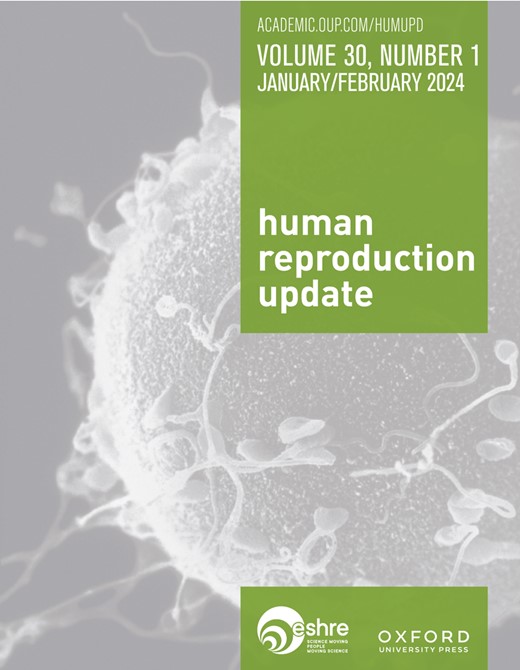Bioengineering trends in female reproduction: a systematic review
IF 14.8
1区 医学
Q1 OBSTETRICS & GYNECOLOGY
引用次数: 11
Abstract
Abstract BACKGROUND To provide the optimal milieu for implantation and fetal development, the female reproductive system must orchestrate uterine dynamics with the appropriate hormones produced by the ovaries. Mature oocytes may be fertilized in the fallopian tubes, and the resulting zygote is transported toward the uterus, where it can implant and continue developing. The cervix acts as a physical barrier to protect the fetus throughout pregnancy, and the vagina acts as a birth canal (involving uterine and cervix mechanisms) and facilitates copulation. Fertility can be compromised by pathologies that affect any of these organs or processes, and therefore, being able to accurately model them or restore their function is of paramount importance in applied and translational research. However, innate differences in human and animal model reproductive tracts, and the static nature of 2D cell/tissue culture techniques, necessitate continued research and development of dynamic and more complex in vitro platforms, ex vivo approaches and in vivo therapies to study and support reproductive biology. To meet this need, bioengineering is propelling the research on female reproduction into a new dimension through a wide range of potential applications and preclinical models, and the burgeoning number and variety of studies makes for a rapidly changing state of the field. OBJECTIVE AND RATIONALE This review aims to summarize the mounting evidence on bioengineering strategies, platforms and therapies currently available and under development in the context of female reproductive medicine, in order to further understand female reproductive biology and provide new options for fertility restoration. Specifically, techniques used in, or for, the uterus (endometrium and myometrium), ovary, fallopian tubes, cervix and vagina will be discussed. SEARCH METHODS A systematic search of full-text articles available in PubMed and Embase databases was conducted to identify relevant studies published between January 2000 and September 2021. The search terms included: bioengineering, reproduction, artificial, biomaterial, microfluidic, bioprinting, organoid, hydrogel, scaffold, uterus, endometrium, ovary, fallopian tubes, oviduct, cervix, vagina, endometriosis, adenomyosis, uterine fibroids, chlamydia, Asherman’s syndrome, intrauterine adhesions, uterine polyps, polycystic ovary syndrome and primary ovarian insufficiency. Additional studies were identified by manually searching the references of the selected articles and of complementary reviews. Eligibility criteria included original, rigorous and accessible peer-reviewed work, published in English, on female reproductive bioengineering techniques in preclinical (in vitro/in vivo/ex vivo) and/or clinical testing phases. OUTCOMES Out of the 10 390 records identified, 312 studies were included for systematic review. Owing to inconsistencies in the study measurements and designs, the findings were assessed qualitatively rather than by meta-analysis. Hydrogels and scaffolds were commonly applied in various bioengineering-related studies of the female reproductive tract. Emerging technologies, such as organoids and bioprinting, offered personalized diagnoses and alternative treatment options, respectively. Promising microfluidic systems combining various bioengineering approaches have also shown translational value. WIDER IMPLICATIONS The complexity of the molecular, endocrine and tissue-level interactions regulating female reproduction present challenges for bioengineering approaches to replace female reproductive organs. However, interdisciplinary work is providing valuable insight into the physicochemical properties necessary for reproductive biological processes to occur. Defining the landscape of reproductive bioengineering technologies currently available and under development for women can provide alternative models for toxicology/drug testing, ex vivo fertility options, clinical therapies and a basis for future organ regeneration studies.女性生殖的生物工程趋势:系统综述
背景:为了提供植入和胎儿发育的最佳环境,女性生殖系统必须通过卵巢产生的适当激素协调子宫动力学。成熟的卵母细胞可以在输卵管中受精,产生的受精卵被运送到子宫,在那里它可以植入并继续发育。子宫颈在整个怀孕期间起到保护胎儿的物理屏障的作用,而阴道则起到产道(包括子宫和子宫颈机制)的作用,促进交配。影响这些器官或过程的任何病理都可能损害生育能力,因此,能够准确地模拟它们或恢复它们的功能在应用和转化研究中至关重要。然而,人类和动物模型生殖道的先天差异,以及二维细胞/组织培养技术的静态特性,需要继续研究和开发动态和更复杂的体外平台、离体方法和体内疗法,以研究和支持生殖生物学。为了满足这一需求,生物工程正在通过广泛的潜在应用和临床前模型将女性生殖研究推向一个新的维度,研究的数量和种类的迅速增加使得该领域的状态迅速变化。目的与原理综述了女性生殖医学背景下生物工程策略、平台和治疗方法的研究进展,以期进一步了解女性生殖生物学,为生殖恢复提供新的选择。具体来说,将讨论用于子宫(子宫内膜和子宫肌层)、卵巢、输卵管、子宫颈和阴道的技术。检索方法系统检索PubMed和Embase数据库中的全文文章,确定2000年1月至2021年9月间发表的相关研究。搜索词包括:生物工程、生殖、人工、生物材料、微流体、生物打印、类器官、水凝胶、支架、子宫、子宫内膜、卵巢、输卵管、子宫颈、阴道、子宫内膜异位症、子宫腺肌症、子宫肌瘤、衣原体、阿什曼综合征、宫内粘连、子宫息肉、多囊卵巢综合征和原发性卵巢功能不全。通过人工检索所选文章和补充评论的参考文献来确定其他研究。资格标准包括在临床前(体外/体内/离体)和/或临床试验阶段发表的关于女性生殖生物工程技术的原创、严格和可访问的同行评审工作。结果:在10390份记录中,312项研究被纳入系统评价。由于研究测量和设计的不一致性,研究结果进行了定性评估,而不是通过荟萃分析。水凝胶和支架广泛应用于女性生殖道生物工程相关研究。新兴技术,如类器官和生物打印,分别提供了个性化诊断和替代治疗方案。结合各种生物工程方法的有前途的微流体系统也显示出转化价值。调节女性生殖的分子、内分泌和组织水平相互作用的复杂性为生物工程方法替代女性生殖器官提出了挑战。然而,跨学科的工作正在为生殖生物学过程发生所必需的物理化学特性提供有价值的见解。确定目前可用和正在为妇女开发的生殖生物工程技术的前景,可以为毒理学/药物测试、体外生育选择、临床治疗和未来器官再生研究提供替代模型。
本文章由计算机程序翻译,如有差异,请以英文原文为准。
求助全文
约1分钟内获得全文
求助全文
来源期刊

Human Reproduction Update
医学-妇产科学
CiteScore
28.80
自引率
1.50%
发文量
38
期刊介绍:
Human Reproduction Update is the leading journal in its field, boasting a Journal Impact FactorTM of 13.3 and ranked first in Obstetrics & Gynecology and Reproductive Biology (Source: Journal Citation ReportsTM from Clarivate, 2023). It specializes in publishing comprehensive and systematic review articles covering various aspects of human reproductive physiology and medicine.
The journal prioritizes basic, transitional, and clinical topics related to reproduction, encompassing areas such as andrology, embryology, infertility, gynaecology, pregnancy, reproductive endocrinology, reproductive epidemiology, reproductive genetics, reproductive immunology, and reproductive oncology. Human Reproduction Update is published on behalf of the European Society of Human Reproduction and Embryology (ESHRE), maintaining the highest scientific and editorial standards.
 求助内容:
求助内容: 应助结果提醒方式:
应助结果提醒方式:


